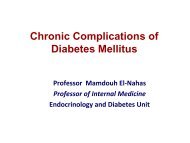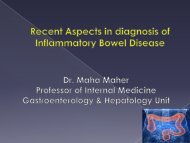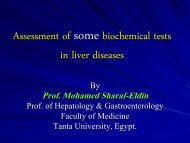HBV DNA
HBV DNA
HBV DNA
Create successful ePaper yourself
Turn your PDF publications into a flip-book with our unique Google optimized e-Paper software.
<strong>HBV</strong> Treatment Guidelines<br />
By:<br />
Prof.Dr. Abdelfatah Hanno<br />
Professor of Tropical Medicine<br />
Alexandria Faculty of Medicine
• A 29 Y old lady diagnosed as chronic <strong>HBV</strong><br />
3 years ago during her pregnancy , no<br />
treatment was offered at that time except for<br />
ALT monitoring every 3 months by her GP.<br />
• Now, referred to liver specialist as she<br />
wants to be pregnant again
Family history and other histories:<br />
• Parents alive and non reactive for HBs Ag<br />
• One brother tested and is HBs Ag reactive<br />
• Patient denies any other risk factor for <strong>HBV</strong><br />
infection , feels unusual fatigue , no<br />
abnormal findings in physical examination
Laboratory investigations<br />
• Total bilirubin: 0.7 mg/dl<br />
• ALT: 210 IU/L<br />
• Serum albumin : 4.2 gm/dl<br />
• Hb :12 gm/dl<br />
• PLT,WBC: N<br />
• PT:12 sec<br />
• HBs Ag : reactive<br />
• HBe Ag : reactive<br />
• <strong>HBV</strong> <strong>DNA</strong>: 26000 IU/ml<br />
Repeated viral markers after 3 months:<br />
• HBs Ag : reactive<br />
• HBe Ag : reactive<br />
• <strong>HBV</strong> <strong>DNA</strong>: 39000 IU/ml<br />
• ALT: 290 IU/L<br />
Liver biopsy: liver architecture is intact but there is significant lobular hepatitis with stage I,II<br />
fibrosis
IS THIS LADY INDICATED FOR<br />
TREATMENT?
APASL Guidelines of treatment in chronic hepatitis B<br />
HBSAg-positive<br />
Hbe Ag +ve<br />
Hbe Ag -ve<br />
<strong>DNA</strong> more<br />
than or<br />
equal<br />
20000<br />
IU/ML<br />
+<br />
ALT 2-5<br />
ULN<br />
<strong>DNA</strong> more<br />
than or equal<br />
20000 IU/ML<br />
+<br />
ALT 1-2 ULN<br />
+<br />
Moderate<br />
inflammation<br />
or fibrosis<br />
<strong>DNA</strong> more<br />
than or<br />
equal 2000<br />
IU/ML<br />
+<br />
ALT more<br />
than 2<br />
ULN<br />
<strong>DNA</strong> more than<br />
or equal 20000<br />
IU/ML<br />
+<br />
ALT 1-2 ULN<br />
+<br />
Moderate<br />
inflammation or<br />
fibrosis<br />
Adapted from APASL2008;21(Suppl C):5C-24C.
The 2009 (AASLD) guidelines<br />
• HBeAg positive<br />
– <strong>HBV</strong> <strong>DNA</strong> > 20,000 IU/mL and ALT > 2 x ULN*<br />
– Consider biopsy if age > 40 yrs, ALT 1-2 x ULN, or<br />
family history of HCC; treat if moderate to severe<br />
necroinflammation and/or fibrosis.<br />
• HBeAg-negative patients<br />
– <strong>HBV</strong> <strong>DNA</strong> > 2,000 IU/mL and ALT > 2 x ULN*<br />
– <strong>HBV</strong> <strong>DNA</strong> ≥ 2000 IU/mL and ALT 1-2 x ULN:<br />
consider biopsy and treat moderate to severe<br />
necroinflammation and/or fibrosis.
EASL 2010 Guidelines<br />
• The decision to treat depends on pattern of disease, <strong>HBV</strong>-<strong>DNA</strong><br />
level, and presence or absence of significant necroinflammation<br />
and hepatic fibrosis.<br />
• <strong>HBV</strong>-<strong>DNA</strong> thresholds of 20000, 2000 and 2000 IU/ml, are<br />
often used for HbeAg+ve chronic hepatitis, HbeAg –ve chronic<br />
hepatitis and cirrhosis respectively, for initiating therapy .
What are the available treatment options?
• Liver transplantation (decompensated chronic hepatitis B with<br />
cirrhosis)<br />
Standard Treatments for Chronic<br />
Hepatitis B<br />
• Interferon<br />
Peginterferon alfa-2a (Pegasys) 180 mcg/week x 24-48 weeks<br />
• Nucleoside/nucleotide analogues<br />
First-line oral antiviral agents<br />
• Tenofovir<br />
• Entecavir (Baraclude ® ) 0.5 -1 mg daily<br />
Second-line oral antiviral agents<br />
• Lamivudine (Epivir-<strong>HBV</strong> ® ) 100 mg daily<br />
• Adefovir (Hepsera ® ) 10 mg daily<br />
• Telbivudine (Tyzeka ) 600 mg daily
Current Guideline Recommendations<br />
for First-line Therapy<br />
• Peginterferon alfa-2a<br />
– Exceptions: pregnancy, chemotherapy<br />
prophylaxis, decompensated cirrhosis, acute<br />
infection<br />
• Entecavir<br />
• Tenofovir<br />
EASL. J Hepatol. 2009;50:227-242. Liaw YF, et al. Hepatol Int. 2008;2:263-283. Lok AS, et al. Hepatology.<br />
2009;50:661-662.
Factors Driving Selection of<br />
Initial Therapy<br />
Nucleos(t)ide Analogues<br />
Peginterferon<br />
Safety &<br />
tolerability<br />
Barrier to<br />
resistance<br />
(durability)<br />
Efficacy<br />
(potency)<br />
Safety &<br />
tolerability<br />
Efficacy<br />
(potency)<br />
Finite<br />
duration
Only two treatment strategies available –<br />
we need to select the best for each patient<br />
INTERFERON<br />
Aim for off-treatment<br />
immune control and<br />
HBsAg clearance<br />
Durable response through<br />
dual MoA: Immunomodulatory<br />
and antiviral<br />
Finite therapy<br />
NUCLEOSIDE ANALOGS<br />
Aim for on-treatment<br />
viral suppression<br />
Maintained suppression<br />
through continued therapy<br />
Long-term therapy (potentially lifelong<br />
for some)<br />
MoA: Mode of action
Recommended Dosing of<br />
Anti-<strong>HBV</strong> Agents<br />
Agent<br />
Rou<br />
te<br />
Adult<br />
Recommended Dosing<br />
Children<br />
Interferon alfa SQ 5 MU daily or 10 MU 3 x per wk<br />
6 MU/m 2 3 x per wk<br />
(max: 10 MU)<br />
Peginterferon<br />
alfa-2a<br />
SQ 180 µg/wk Not approved<br />
Lamivudine PO 100 mg QD* †<br />
3 mg/kg/day<br />
(max: 100 mg/day)<br />
Adefovir PO 10 mg QD* Not approved ‡<br />
Entecavir<br />
PO<br />
• 0.5 mg QD (no previous LAM)<br />
• 1.0 mg QD (if refr/resist to LAM)*<br />
Not approved<br />
Telbivudine PO 600 mg QD* Not approved<br />
Tenofovir PO 300 mg QD* Not approved<br />
*Dose adjustment needed if eGFR < 50 mL/min. † Persons coinfected with HIV should receive 150 mg BID. Should<br />
only be used in combination with other antiretrovirals. ‡ Approved for ages 12 and older.<br />
Lok AS, et al. Hepatology. 2009;50:661-662.
The First Branch Point in<br />
Choosing<br />
With What to Treat<br />
Decision to treat<br />
IFN<br />
(PegIFN alfa-2a)<br />
Nucleos(t)ide<br />
analogues
PegIFN vs Nucleos(t)ide<br />
PegIFN<br />
Analogues<br />
Nucleos(t)ide Analogues<br />
Pro Con Pro Con<br />
• Finite course of<br />
therapy<br />
• No resistance<br />
• Higher rate of<br />
HBeAg loss in 1 yr<br />
• Higher rate of<br />
HBsAg loss with<br />
short duration<br />
therapy*<br />
• SQ administration<br />
• Frequent AEs<br />
• Contraindicated in<br />
patients with<br />
cirrhosis, in<br />
pregnancy, with<br />
acute hepatitis B,<br />
and who are<br />
immunosuppressed<br />
*Particularly for HBeAg-positive patients with genotype A infection.<br />
†<br />
Recent case report of lactic acidosis in severe liver failure.<br />
• PO<br />
administration<br />
• Infrequent AEs<br />
• Safe for<br />
patients with<br />
decompensated<br />
disease †<br />
• Need for longterm<br />
or indefinite<br />
therapy<br />
• Potential for drug<br />
resistance<br />
Lok AS. Hepatology. 2010;52:743-747. Buster EH, et al. Gastroenterology. 2008;135:459-467.<br />
Lange CM, et al. Hepatology. 2009;50:2001-2006.
When to Consider PegIFN<br />
• Favorable predictors of<br />
response [1,2]<br />
– Low <strong>HBV</strong> <strong>DNA</strong>*<br />
– High ALT*<br />
– Genotype A or B > C or D [3-5]<br />
• Specific patient<br />
demographics [1,2]<br />
– Generally young people<br />
– Young women wanting<br />
pregnancy in near future<br />
– Absence of comorbidities<br />
• Patient preference [1,2]<br />
• Concomitant HCV infection<br />
*Also predictive of response to nucleos(t)ide analogues.<br />
1. Lok AS, et al. Hepatology. 2009;50:661-662. 2. Lok AS. Hepatology. 2010;52:743-747.<br />
3. Janssen HL, et al, Lancet. 2005;365;123-129. 4. Lau GK, et al. N Engl J Med. 2005;352:2682-2695. 5. Flink<br />
HJ, et al. Am J Gastroenterol. 2006;101:297-303.
The Second Branch Point in<br />
Choosing<br />
With What to Treat<br />
Nucleos(t)ide<br />
analogues<br />
Lamivudine<br />
Adefovir<br />
Entecavir Telbivudine Tenofovir
Antiviral therapy is a matter<br />
of choice!!
Patients With Undetectable<br />
<strong>HBV</strong> <strong>DNA</strong> (%)<br />
Virologic Response in HBeAg+ Patients<br />
(Undetectable* <strong>HBV</strong> <strong>DNA</strong> at Wk 48-52)<br />
Not head-to-head trials; different patient populations and trial designs<br />
100<br />
80<br />
60<br />
40<br />
40-44<br />
67<br />
60<br />
76<br />
20<br />
21<br />
0<br />
LAM ADV ETV LdT TDF<br />
*By PCR based assay (LLD ~ 50 IU/mL) except for some LAM studies.<br />
Adapted from Lok AS, et al. Hepatology. 2007;45:507-539.<br />
Heathcote EJ, et al. AASLD 2007. Abstract LB6.
Patients With Undetectable<br />
<strong>HBV</strong> <strong>DNA</strong> (%)<br />
Virologic Response in HBeAg- Patients<br />
(Undetectable* <strong>HBV</strong> <strong>DNA</strong> at Wk 48-52)<br />
Not head-to-head trials; different patient populations and trial designs<br />
100<br />
90<br />
93<br />
88<br />
80<br />
~ 70<br />
60<br />
51<br />
40<br />
20<br />
0<br />
LAM ADV ETV LdT TDF<br />
*By PCR based assay (LLD ~ 50 IU/mL) except for some LAM studies.<br />
Adapted from Lok AS, et al. Hepatology 2007;45:507-539.<br />
Marcellin P, et al. AASLD 2007. Abstract LB2.
Cumulative Rates of Resistance With Oral<br />
Agents in Nucleos(t)ide-Naive Patients<br />
Drug<br />
Generation<br />
Not head-to-head trials; different patient populations and trial designs<br />
Yr 1 Yr 2 Yr 3 Yr 4 Yr 5 Yr 6<br />
1st<br />
LAM<br />
24% 38% 49% 67%<br />
70%<br />
2nd<br />
3rd<br />
ADV<br />
LdT<br />
ETV<br />
TDF<br />
0% 3% 11% 18%<br />
4% 17%<br />
0.2% 0.5% 1.2% 1.2% 1.2% 1.2%<br />
0% 0% 0%<br />
29%<br />
EASL. J Hepatol. 2009;50:227-242. Tenny DJ, et al. EASL 2009. Abstract 20.<br />
Marcellin P, et al. AASLD 2009. Abstract 481. Heathcote E, et al. AASLD 2009. Abstract 483.
Therapy selected<br />
• Patient mentioned her wish to become<br />
pregnant in the not too distant future, she<br />
wanted to try finite treatment.<br />
• Peg Interferon 180 Mcgm weekly started<br />
for 1 year.
On-Treatment Monitoring and<br />
Response Evaluation
Monitoring of Patients Receiving<br />
(Peg)IFN Therapy<br />
Time Point<br />
During treatment<br />
Every 4 wks<br />
Every 12 wks<br />
Every 24 wks<br />
Posttreatment<br />
Every 12 wks during first<br />
24 wks<br />
Monitoring<br />
• Blood counts<br />
• Liver panel<br />
• TSH<br />
• <strong>HBV</strong> <strong>DNA</strong> levels<br />
• HBeAg/anti-HBe (if initially HBeAg positive)<br />
• Blood counts<br />
• Liver panel<br />
• TSH<br />
• <strong>HBV</strong> <strong>DNA</strong><br />
• HBeAg/anti-HBe (if initially HBeAg positive)<br />
Lok AS, et al. Hepatology. 2009;50:661-662.
Monitoring of Patients Receiving<br />
Nucleos(t)ide Analogue Therapy<br />
Time Point<br />
Every 12 wks<br />
Every 12-24 wks<br />
Every 24 wks<br />
Every 6-12 mos<br />
Monitoring<br />
• Liver panel<br />
• Serum creatinine (if receiving TDF or ADV)<br />
• <strong>HBV</strong> <strong>DNA</strong> levels<br />
• HBeAg/anti-HBe (if initially HBeAg positive)<br />
• HBsAg in HBeAg-negative patients with<br />
persistently undetectable <strong>HBV</strong> <strong>DNA</strong><br />
Lok AS, et al. Hepatology. 2009;50:661-662.
•During treatment with Peg Interferon<br />
month ALT <strong>DNA</strong> by PCR<br />
3 M (12 w) 32
• No HBe Ag seroconversion is seen.
Defining treatment response?
Phases of response of chronic<br />
<strong>HBV</strong> to treatment<br />
1. Phase 1 : decrease viral replication and<br />
viral <strong>DNA</strong>.<br />
2. Phase 2 : Seroconversion to Hbe<br />
negative.<br />
3. Phase 3 : loss of HBs Ag and the<br />
apperance of anti HBs.
Definitions of Respone to anti-<br />
<strong>HBV</strong> Treatment<br />
• Complete virologic response is defined as <strong>HBV</strong><br />
<strong>DNA</strong> levels < 60 IU/mL (< 300 copies/mL)<br />
• Partial virologic response is defined as residual<br />
<strong>HBV</strong> <strong>DNA</strong> levels < 2000 IU/mL (< 4 log 10<br />
copies/mL) at week 24.<br />
• Inadequate virologic response is defined as<br />
residual <strong>HBV</strong> <strong>DNA</strong> levels ≥ 2000 IU/mL (≥ 4<br />
log 10 copies/mL) at week 24
Definition of Response to<br />
Antiviral Therapy<br />
Response<br />
Primary nonresponse*<br />
Biochemical response<br />
Virologic response<br />
Histologic response<br />
Complete response<br />
Definition<br />
↓ in serum <strong>HBV</strong> <strong>DNA</strong> by < 2 log 10 IU/mL after ≥ 24 wks of<br />
therapy<br />
↓ in serum ALT to within the normal range<br />
↓ in serum <strong>HBV</strong> <strong>DNA</strong> to undetectable levels by PCR and loss of<br />
HBeAg in patients who were initially HBeAg positive<br />
↓ in histology activity index by ≥ 2 points and no worsening of<br />
fibrosis score compared to pretreatment liver biopsy<br />
Fulfill criteria of biochemical and virologic response and HBsAg<br />
loss<br />
*Not applicable to interferon therapy.<br />
Lok AS, et al. Hepatology. 2009;50:661-662. Chronic Hepatitis B: Update 2009, Lok ASF, McMahon BJ,<br />
www.aasld.org. Copyright@2009. American Association for the Study of Liver Diseases. Reproduced with<br />
permission of the American Association for the Study of Liver Diseases.
What are the on treatment<br />
predictors?
Predictors of HBsAg Loss in<br />
HBeAg-Positive Patients<br />
• Race: whites > nonwhites [1]<br />
• Genotype [1-3]<br />
– Nucleos(t)ide analogues: A and D<br />
– Peginterferon: A<br />
• Decline in HBsAg level during first 24 wks with<br />
nucleos(t)ide analogues [1]<br />
• HBeAg negative at or within 26 wks of<br />
completing peginterferon treatment [3]<br />
1. Heathcote EJ, et al. EASL 2009. Abstract 909. 2. Gish RG, et al. J Viral Hepat. 2010;17:16-22.<br />
3. Buster EH, et al. Gastroenterology. 2008;135;459-467.
Utility of on-treatment markers for<br />
predicting treatment response<br />
• HBeAg level<br />
No commercially assay currrently available<br />
Applicable to HBeAg-positive only<br />
• HBsAg level<br />
Appropriate for both HBeAg-positive and -negative<br />
Reflects ccc<strong>DNA</strong> in infected cells<br />
Initial findings on clinical utility are encouraging<br />
• <strong>HBV</strong> <strong>DNA</strong> level<br />
Does not differentiate between responders and relapsers<br />
Wong, Chan. Drugs 2009
<strong>HBV</strong> <strong>DNA</strong> as on treatment predictor<br />
• The benefit of monitoring the viral load during treatment is<br />
probably limited.<br />
• <strong>DNA</strong> decline improves prediction of sustained response, and<br />
it is recommended to discontinue therapy in patients in whom<br />
an <strong>HBV</strong> <strong>DNA</strong> decline of 2 log10 at week 24 is not achieved .<br />
• In parallel with <strong>HBV</strong> <strong>DNA</strong>, quantitative assays for HBeAg<br />
and HBsAg have become available
HBe Ag Levels as on treatment predictor<br />
• Monitoring serum HBeAg levels during<br />
treatment may help to predict the<br />
probability of subsequent HBeAg loss or<br />
seroconversion.<br />
• At 24 weeks of therapy, high HBeAg levels<br />
had a greater negative predictive value<br />
(96%) compared with <strong>HBV</strong> <strong>DNA</strong> levels at<br />
the same time point
HBsAg level as a key to response-guided<br />
therapy in future treatment paradigms<br />
• Serum HBsAg levels probably reflect intrahepatic ccc<strong>DNA</strong>,<br />
the key replicative intermediate .<br />
• On-treatment reduction of HBsAg may reflect the reduced<br />
intrahepatic ccc<strong>DNA</strong> concentrations..<br />
• HBsAg is the only viral marker that remains detectable in the<br />
serum of CHB patients who become HBeAg negative
Benefits of on-treatment HBsAg monitoring<br />
• Week 12 HBsAg decline<br />
≥10% decline is an early sign of future success<br />
Helps motivate the patient<br />
• Week 24 HBsAg decline<br />
Greater chance of sustained immune control and<br />
HBsAg clearance<br />
Marcellin et al. APASL 2010
Proportion of patients who achieved a≥10%<br />
decline in HBsAg increased by Week 24<br />
% HBeAg-negative patients achieving HBsAg decline ≥10%<br />
Week 12:<br />
Patient<br />
motivation<br />
Week 24:<br />
Predict with<br />
more confidence<br />
44%<br />
N=53/120<br />
56%<br />
N=67/120<br />
Marcellin et al. APASL 2010
HBsAg reduction at Week 24 is an early sign of<br />
future HBsAg clearance<br />
HBeAg-negative patients<br />
45%<br />
HBsAg clearance<br />
5 years post-treatment<br />
43%<br />
<strong>HBV</strong> <strong>DNA</strong> ≤10,000<br />
copies/mL<br />
1 year post- treatment<br />
Among HBeAg-negative patients<br />
who achieved HBsAg decline<br />
≥10% from baseline at Week 24 of<br />
treatment*<br />
SUSTAINED<br />
IMMUNE<br />
CONTROL<br />
*56% of patients achieved HBsAg decline ≥10% at Week 24<br />
Marcellin et al. APASL 2010
• After 6 months of pegylated Interferon<br />
treatment , she become pregnant and her<br />
ALT is normal and <strong>HBV</strong> <strong>DNA</strong> : < 60 Iu/ml<br />
, however No HBeAg seroconversion<br />
occured
Third trimester of pregnancy<br />
• ALT: 24 IU/L<br />
• <strong>HBV</strong> <strong>DNA</strong>:60 IU/ml<br />
• HBeAg :reactive
questions<br />
• Will you add lamivudine in this stage?<br />
• How will you treat the newborn for<br />
prevention of <strong>HBV</strong> transmission?<br />
• Can she feed her new born?
• No therapy was given<br />
• The newborn was given both active and<br />
passive immunization<br />
• The baby started on breast feeding.
EASL 2010 recommendations<br />
Pregnancy and Breastfeeding<br />
• Vertical transmission (mother to infant) of infection occurs in 65-<br />
90% of pregnancies where the mother is HBeAg positive and in<br />
about ten percent of HBsAg positive, HBeAg negative<br />
mothers,Most (>90%) of infected infants become chronic carriers.<br />
• Infants born to HBsAg positive mothers are vaccinated from birth,<br />
sometimes in combination with Hepatitis B specific<br />
Immunoglobulin (HBSIg) 200 i.u intramuscularly [IIa,B],This<br />
reduces vertical transmission by approximately ninety percent.<br />
• There is some evidence that lamivudine may further reduce vertical<br />
transmission if given to women with a high <strong>HBV</strong>-<strong>DNA</strong> viral load in<br />
the third trimester [Ib, A], However, if HBSIg is not available,<br />
vaccination alone prevents vertical transmission in 66-100% [IIa,<br />
B]. Infants should be tested for hepatitis B (HBsAg and anti-HBs) 4-<br />
6 weeks after the final dose of vaccine [IV, C].<br />
• Infected mothers should continue to breast feed as there is no<br />
additional risk of transmission.
• At 4.5 months post pregnancy she developed<br />
again unusual fatigue<br />
Lab investigations:<br />
• HBs Ag : reactive<br />
• HBe Ag: reactive<br />
• <strong>HBV</strong> <strong>DNA</strong>: 29000 IU/ml<br />
• ALT: 310 IU/ml<br />
• Total bilirubin: 1.3 mg/dl
questions<br />
• What are the possible causes of flare in<br />
ALT level and reappearance of <strong>HBV</strong> <strong>DNA</strong>?<br />
• Would you consider treatment?<br />
• If yes<br />
1. Pegylated interferon<br />
2. Oral antiviral
• A significant increase in liver inflammation occurs often after pregnancy. This<br />
may be due to a reactivation of the immune system after delivery."<br />
• A significant increase in liver disease activity within six months after the<br />
mothers gave birth. Based on characteristics such as the mother's status as<br />
having chronic liver disease or being an <strong>HBV</strong> carrier, the authors stated that it<br />
was not possible to predict during pregnancy which women would experience<br />
liver disease exacerbations. This means that regardless of the status of <strong>HBV</strong><br />
infection, pregnant women who have been infected with <strong>HBV</strong> are susceptible<br />
to its resurgence following delivery.<br />
• Likely due to the immunologic changes that accompany a woman as she<br />
gestates and produces a new human being, the Hepatitis B virus can flourish in<br />
a pregnant woman's body. Because so many people have antigens to <strong>HBV</strong>, this<br />
possibility must be known to expectant mothers and their caregivers.
• She started on lamivudine 100 mg/day<br />
month ALT eAg <strong>HBV</strong> <strong>DNA</strong><br />
3 M 100 +VE Less than 60 IU/ml<br />
6 M 21 +VE but level<br />
decrease markedly<br />
Less than 60 IU/ml<br />
12 M 21 Non reactive and<br />
HBe Ab +VE<br />
Less than 60 IU/ml<br />
18 M 18 HBeAG:non reactive<br />
HBeAb:reactive<br />
Less than 60 IU/ml
Questions<br />
• How would you define the above response?<br />
• When you will stop the treatment?
What are the endpoints of<br />
treatment?
Therapeutic strategy defines which endpoint is<br />
appropriate for determining success<br />
• PEG-IFN<br />
Aim for sustained response after a finite course of therapy<br />
through immunologically mediated control <strong>HBV</strong> <strong>DNA</strong><br />
≤10,000 copies/mL for HBeAg-negative HBeAg<br />
seroconversion for HBeAg-positive<br />
• NAs<br />
Aim for maintained suppression of viral replication<br />
Undetectable levels of <strong>HBV</strong> <strong>DNA</strong> are needed to prevent<br />
resistance
Relevance of efficacy endpoints<br />
2. Inactive HBsAg carrier status<br />
Sustained immune control<br />
1. HBsAg clearance<br />
3. <strong>HBV</strong> <strong>DNA</strong> suppression<br />
<strong>HBV</strong> <strong>DNA</strong>
Guidelines<br />
HBsAg clearance is the “Ideal endpoint”<br />
• AASLD, EASL and APASL guidelines all<br />
acknowledge the importance of HBsAg<br />
clearance<br />
“Key role in the natural history of chronic<br />
<strong>HBV</strong> infection”<br />
• EASL guidelines (J Hepatol 2009)<br />
“... is associated with a complete and definitive<br />
remission of the activity of CHB and an improved<br />
long-term outcome”
AASLD guidelines (2009)<br />
• Recommend that patients with chronic<br />
hepatitis B who are HBe Ag +ve , treatment<br />
should be continued until the patient achieves<br />
seroconversion and has completed at least 6<br />
months of additional treatment after the<br />
apperance of anti Hbe.<br />
• In patients with Hbe Ag -ve form of the<br />
disease , treatment should be continued until<br />
the patient has achieved HBs Ag clearance
•HBs Ag seroclearance<br />
represent the preferred end<br />
point of therapy of chronic<br />
hepatitis B
Why is HBs Ag the best end point?<br />
• Serum HBsAg levels probably reflect intrahepatic ccc<strong>DNA</strong>,<br />
the key replicative intermediate .<br />
• HBs Ag seroclearance represent the preferred end point of<br />
therapy of chronic hepatitis B as it is believed to represent<br />
successful immunological control of active <strong>HBV</strong> replication.<br />
• serum HBsAg loss comes as close to clinical cure and is<br />
clearly associated with improved outcomes, provided that<br />
HBsAg clearance occurs before the development of cirrhosis<br />
• HBsAg is the only viral marker that remains detectable in the<br />
serum of CHB patients who become HBeAg negative.
HBeAg seroconversion as an end point of<br />
treatment<br />
• HBeAg seroconversion is frequently used as a<br />
primary endpoint in HBeAg-positive patients<br />
treated with PEG-IFN.<br />
• Most patients enter an inactive carrier state after<br />
achieving HBeAg seroconversion, characterized by<br />
low or undetectable <strong>HBV</strong> <strong>DNA</strong> levels and<br />
normalization of ALT levels.<br />
• Long-term follow-up studies have demonstrated<br />
that HBeAg seroconversion is associated with<br />
increased survival and a reduced risk of developing<br />
HCC .
Inactive disease is what we want to<br />
achieve<br />
HBeAg<br />
<strong>HBV</strong> <strong>DNA</strong><br />
Anti-HBe<br />
ALT<br />
Immune<br />
tolerant<br />
Immune clearance<br />
HBeAg +ve CHB<br />
Immune<br />
control<br />
(inactive)<br />
CHB<br />
Reactivation<br />
HBeAg –ve CHB<br />
HBsAg<br />
cleared<br />
Lok et al. Arch Intern Med 2006
Survival probability<br />
Inactive CHB is associated with good<br />
prognosis<br />
25-year survival rates in untreated CHB<br />
100<br />
Inactive CHB<br />
80<br />
60<br />
40<br />
20<br />
HBeAg-/<strong>HBV</strong> <strong>DNA</strong>+<br />
or HBeAg reversion<br />
HBeAg+ persistence<br />
0<br />
0 5 10 15 20 25<br />
Time (years)<br />
Fattovich et al. Gut 2008
suppression of <strong>HBV</strong> <strong>DNA</strong> as an end<br />
point of treatment<br />
• HBeAg seroconversion is by definition not possible in<br />
HBeAg-negative patients.<br />
• Thus, suppression of <strong>HBV</strong> <strong>DNA</strong> to low or undetectable<br />
levels in combination with normalization of ALT is<br />
considered the most important treatment goal.<br />
• Response to therapy is defined by the sustained presence of<br />
an <strong>HBV</strong> <strong>DNA</strong> level below 2,000 IU/mL according to the<br />
European guidelines.
HCC (% per year)<br />
<strong>HBV</strong> <strong>DNA</strong>
• She achieved HBeAg seroconversion.<br />
• Stop the treatment according to the current<br />
guidelines
AASLD Guideline Recommendations<br />
for Duration of NA Treatment<br />
“32. Duration of nucleoside analogue treatment<br />
a. HBeAg-positive chronic hepatitis B—Treatment should be<br />
continued until the patient has achieved HBeAg seroconversion and<br />
undetectable serum <strong>HBV</strong> <strong>DNA</strong> and completed at least 6 mos of<br />
additional treatment after appearance of anti-HBe. (I)<br />
● Close monitoring for relapse is needed after withdrawal of<br />
treatment. (I)<br />
b. HBeAg-negative chronic hepatitis B—Treatment should be<br />
continued until the patient has achieved HBsAg clearance. (I)”<br />
Lok AS, et al. Hepatology. 2009;50:661-662.
Treatment stopped<br />
Follow up at 12 months:<br />
• ALT:12<br />
• <strong>HBV</strong> <strong>DNA</strong>: less than 60 IU/ml<br />
Maintaining the response
NEPTUNE: PegIFN alfa-2a<br />
Administered for 24 vs 48 Wks<br />
in HBeAg+ Patients<br />
24 wks inferior to 48 wks of pegIFN alfa-2a therapy, regardless of dose,<br />
in randomized, double-blind phase IV study<br />
HBeAg Seroconversion<br />
6 Mos After Rx, %<br />
Liaw Y-F, et al. AASLD 2010. Abstract 215.<br />
24 Wks<br />
(n = 282)<br />
Overall 18.4 30.9<br />
Genotype B 29 36<br />
Genotype C 13 31<br />
48 Wks<br />
(n = 262)<br />
OR (95% CI)<br />
2.17<br />
(1.43-3.31)<br />
1.44<br />
(0.75-2.78)<br />
3.29<br />
(1.76-6.15)<br />
ALT > 1-2 x ULN 11 19 NR --<br />
ALT > 2-5 x ULN 20 36 NR --<br />
ALT > 5-10 x ULN 34 53 NR --<br />
*For noninferiority; ie, nonsignificance = not noninferior.<br />
P Value<br />
.749<br />
.215<br />
.960
Safety of Extending PegIFN alfa-2a<br />
From 48 to 96 Wks in Genotype D<br />
HBeAg- Pts<br />
PegBeLiver: higher virologic/serologic response rates observed 1 yr posttreatment in<br />
HBeAg-negative pts (94% genotype D) treated with pegIFN alfa-2a for 96 vs 48<br />
wks [1]<br />
Safety Outcome [2]<br />
PegIFN Alfa-2a 48 Wks<br />
(n = 51)<br />
PegIFN Alfa-2a 96 Wks<br />
(n = 77)<br />
Treatment discontinuation, % 20 26 .52<br />
Any treatment-related adverse event, % 82 79 .82<br />
Any serious adverse event, % 14 12 .79<br />
Treatment-related serious AE % 4 3 1.00<br />
Dose modification, % 29 21 .30<br />
Death, n 1 0 1.00<br />
Laboratory abnormalities, %<br />
Increased ALT 4 3 1.00<br />
Neutropenia 24 16 .36<br />
Thrombocytopenia 12 10 .77<br />
Anemia 8 5 .71<br />
1. Lampertico P, et al. EASL 2010. Abstract 98. 2. Lampertico P, et al. AASLD 2010. Abstract 135.<br />
P Value
Algorithm for Selecting HBeAg-Positive Patients<br />
for Treatment<br />
HBeAg-positive<br />
<strong>HBV</strong> <strong>DNA</strong><br />
< 20,000 IU/mL<br />
<strong>HBV</strong> <strong>DNA</strong><br />
> 20,000 IU/mL<br />
ALT normal<br />
ALT elevated<br />
for 3-6 months<br />
ALT normal<br />
ALT<br />
elevated<br />
No treatment<br />
Monitor every<br />
3 months with<br />
ALT and <strong>HBV</strong><br />
<strong>DNA</strong><br />
Rule out other<br />
causes of liver<br />
disease<br />
Monitor every<br />
3 months<br />
Consider biopsy if ><br />
35-40 years<br />
Treat if significant<br />
disease<br />
TREAT<br />
Adapted from CASL Consensus Guidelines. Can J Gastroenterol 2009;21(Suppl C):5C-24C.
Tolerability and Safety:<br />
Nucleos(t)ide Analogues vs Peginterferon<br />
Nucleos(t)ide<br />
Analogues<br />
• Safe at all stages of disease,<br />
including decompensated<br />
cirrhosis<br />
• Safe in<br />
immunocompromised<br />
populations<br />
– Selected drugs probably<br />
safe in pregnancy<br />
• Reported toxicities are rare<br />
Peginterferon<br />
• Contraindications<br />
– Decompensated cirrhosis<br />
– Pregnancy<br />
– Chemotherapy prophylaxis<br />
– Acute <strong>HBV</strong> infection<br />
• Not recommended<br />
– Cirrhosis<br />
• Adverse effects common<br />
Lok AS, et al. Hepatology. 2007;45:507-539. Lok AS, et al. Hepatology. 2009;50:661-662.
• The suppression of serum <strong>HBV</strong> <strong>DNA</strong> during treatment appears to be<br />
the best predictor of improved long-term patient outcomes.<br />
• Failure to reduce <strong>HBV</strong> <strong>DNA</strong> levels by 1 log10 IU/mL or more after<br />
12 weeks of treatment is considered an indication of therapeutic<br />
failure.<br />
• Complete viral response after 6 months of oral therapy correlates<br />
with reductions in resistance, HBeAg seroconversion, and continued<br />
negativity of therapy at 1–2 years.
• Monitoring patients during treatment is an important<br />
means of assessing drug safety, compliance, and treatment<br />
responses.<br />
• Early monitoring of <strong>HBV</strong> <strong>DNA</strong> is of particular value to<br />
detect primary treatment failure and predict outcomes of<br />
continued therapy (e.g., improved liver histology, reduced<br />
likelihood of disease progression, the development of drug<br />
resistance).









